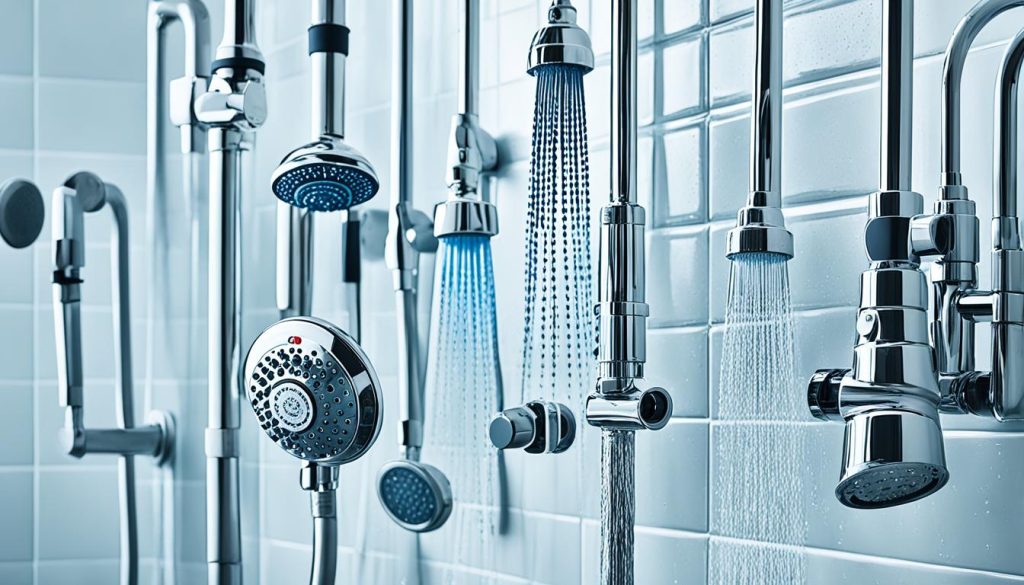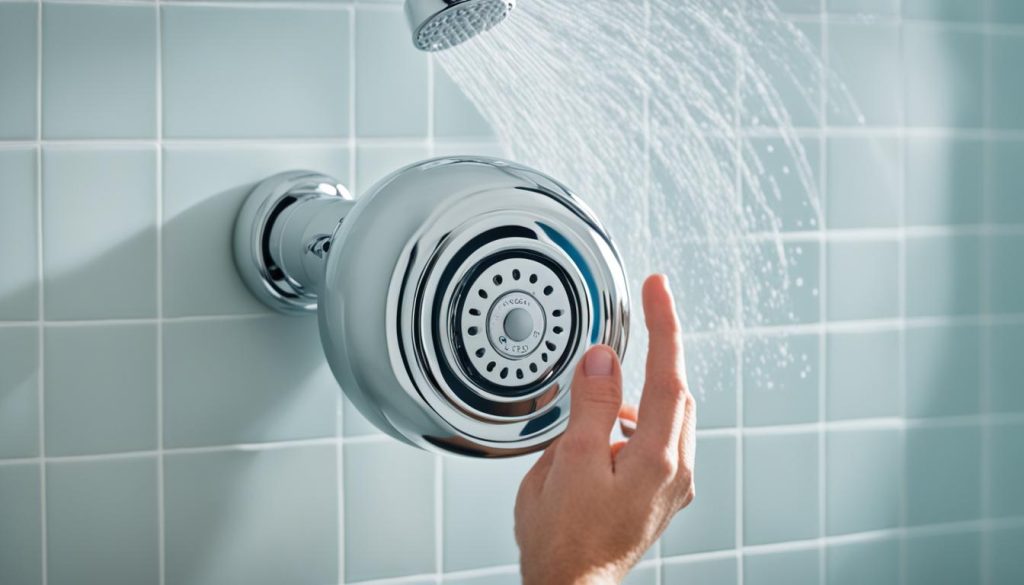Hot Water on Left or Right: Know the Standard
Did you know that the position of the hot tap in your bathroom can vary depending on where you live? It’s a surprising fact that can have a significant impact on your everyday life. Imagine trying to adjust the water temperature, only to find that the hot tap is on the opposite side than what you’re used to. This inconsistency can lead to confusion and difficulties in achieving the perfect water temperature in your daily shower.
Key Takeaways:
- The position of the hot tap in a bathroom can vary depending on personal preferences and regional practices.
- There is no specific law mandating the placement of the hot tap, so it ultimately comes down to individual plumbing choices.
- Consider usability, convenience, and safety when deciding on the placement of hot water taps in your bathroom.
- Consulting with a professional plumber can provide guidance and ensure optimal functionality and user experience.
- When it comes to shower control and faucet placement, consider the overall bathroom layout and the placement of other fixtures for a cohesive and functional design.
Is There a Standard for Hot Water Placement?
The position of the hot tap in a bathroom can vary depending on the location. In the United Kingdom, the majority of homes have the hot tap on the left side of the bathroom sink. This practice is backed by some who believe that having the hot tap on the left makes it easier for blind individuals to identify the correct tap to use. In the United States, there is a uniform plumbing code that specifies the hot water should correspond to the left side of the fittings. However, it is important to note that there is no specific law in the UK mandating the position of the hot tap. The decision ultimately depends on personal preference and individual plumbing choices.
Historical Origins of Hot Water Placement
The position of hot water taps in bathrooms has a rich historical background that dates back to the 19th century. During this time, indoor plumbing was introduced, revolutionizing the way water was supplied to households. Before the advent of modern plumbing systems, water was typically accessed through hand pumps, which provided cold water.
To cater to the convenience of right-handed individuals, the cold tap was placed on the right side of the sink. This positioning allowed for easier access and operation of the tap handle using the dominant right hand.
When hot water became available through advancements in plumbing technology, the logical choice was to place the hot tap on the opposite side of the sink. In most cases, this happened to be the left side.
This convention of placing the hot tap on the left side has persisted over the years, with the majority of homes adhering to this practice. However, it is important to note that there is no specific law mandating the placement of hot water taps.
| Hot Water Placement | Historical Origins |
|---|---|
| Hot Tap on Left Side | Logical choice to place the hot tap on the opposite side of the sink (left) for ease of use for right-handed individuals |
| Hot Tap on Right Side | No distinct historical origin, but some individuals prefer this placement for personal preferences or plumbing considerations |
Considerations for Children and the Visually Impaired
When it comes to hot tap placement in bathrooms, there are specific considerations for children and the visually impaired. The positioning of the hot tap, whether on the left or right side, can play a role in enhancing safety and accessibility for these individuals.
Safety for Children
Placing the hot tap on the furthest side, whether left or right, can help prevent young children from accidentally turning on the hot water and scalding themselves. By placing the hot tap out of reach or on the opposite side of the cold tap, parents can minimize the risk of burns or injuries. This design choice ensures that children need to consciously reach for the hot tap, making it less likely for them to accidentally turn it on.
However, it is essential to note that while this placement can reduce the risk, it is not a foolproof safety measure. Parents should always supervise young children in the bathroom and teach them about hot water safety to avoid accidents.
Accessibility for the Visually Impaired
Having a consistent placement of the hot tap, whether on the left or right, can assist visually impaired individuals in identifying and using the correct tap. By remembering the consistent location of the hot tap, visually impaired individuals can confidently navigate bathroom fixtures and avoid confusion.
While this approach can be helpful for some visually impaired individuals, it is essential to consider other accessibility features in the bathroom, such as tactile indicators, contrasting colors, and clear labeling of taps. These additional measures can further enhance accessibility and ensure a safe and inclusive environment for everyone.
Personal Preferences and Individual Plumbing Choices
When it comes to the placement of the hot tap in your bathroom, it ultimately boils down to personal preferences and individual plumbing choices. While there may be conventions and regional practices, there is no hard and fast rule dictating where the hot tap should be positioned. Some people may choose to deviate from the norm and place the hot tap on the right side of the sink, while others may opt for mixer taps that combine hot and cold water into a single faucet.
When making decisions about tap placement, it’s essential to consider various factors. Usability is crucial—think about which placement feels more natural and intuitive for you. Convenience is also key—consider the ease of use and accessibility for yourself and your family members. Additionally, safety should be a top priority. Ensure that the chosen placement minimizes the risk of accidental scalding and provides a safe environment, especially if you have young children or elderly individuals at home.
Consulting with a professional plumber can help you navigate through the options and ensure that your chosen tap placement is both functional and aligned with your personal preferences. Their expertise and experience will guide you in making informed decisions that enhance the usability and aesthetics of your bathroom.
Factors to Consider for Tap Placement:
- Usability and convenience for everyday use
- Safety measures to minimize the risk of accidents
- Aesthetics and overall bathroom design
- Individual preferences and desired user experience
Tips for Optimal Shower Control and Faucet Placement
When it comes to creating the perfect shower experience, shower water control and hot water faucet placement play crucial roles. Follow these tips to ensure optimal functionality and convenience in your bathroom renovation:
Easily Accessible and Intuitive Controls
Make sure that the shower handles or knobs are easily reachable and intuitive to use. This allows for a smooth and seamless shower experience. Placing the hot water knob on the left side and the cold water knob on the right side is a common convention that provides a familiar user experience.
Consider the Bathroom Layout
Take into account the overall layout of your bathroom when determining the ideal position for the shower controls and faucets. Consider the placement of other fixtures such as the sink and toilet to ensure a cohesive and functional design. Consulting with a professional plumber can help you make the best decisions for your specific bathroom layout.
Upgrade to a Thermostatic Mixer
If you’re looking for more precise control over water temperature, consider upgrading to a thermostatic mixer. These mixers allow you to set the desired water temperature and maintain it throughout your shower, ensuring a consistent and comfortable bathing experience.
Install Shower Systems with Multiple Jets
If you want to enhance your shower experience, consider installing shower systems with multiple jets. These systems allow you to customize the water flow and massage effect to suit your preferences. Some models even offer programmable settings for a truly personalized shower experience.
Use Waterproof and Easy-to-Clean Materials
When renovating your bathroom, choose waterproof and easy-to-clean materials for your shower area. Opt for tiles, glass panels, or waterproof wall panels to minimize maintenance and keep your shower looking fresh and clean.
By following these tips, you can ensure optimal shower water control and hot water faucet placement in your bathroom renovation, resulting in a functional and enjoyable bathing experience.
Conclusion
After exploring the various factors surrounding the placement of hot water taps in bathrooms, it is clear that there is no definitive rule or law mandating a specific position. The decision of whether to have the hot tap on the left or right ultimately comes down to personal preferences and regional practices. While some arguments exist for having a standard placement, such as for the convenience of blind individuals or the safety of children, it is important to consider usability, convenience, and safety when making tap placement decisions.
When undertaking bathroom renovations or new installations, consulting with a professional plumber is crucial to ensure optimal functionality and user experience. They can provide expert guidance based on their knowledge of plumbing standards and best practices. By considering various factors like the layout of the bathroom, the placement of other fixtures, and the needs of the household, a professional plumber can help determine the ideal tap placement that aligns with the individual’s preferences.
In conclusion, the placement of hot water taps, whether on the left or right side, is a matter of personal choice. There is no one-size-fits-all solution, as preferences can vary from person to person and from region to region. By considering factors such as usability, convenience, and safety, individuals can make informed decisions that result in functional and aesthetically pleasing bathroom designs. Whether you choose to follow the traditional convention or deviate from it, the goal should always be to create a space that meets your needs and enhances your overall bathing experience.
- Investing Wisely: How Windows & Doors in Boost Property Value and Financial Health - April 24, 2025
- The Financial Impact of Personal Injuries: Why Legal Help Matters for Business Owners - April 16, 2025
- The Hidden Financial Costs of Domestic Assault: What Business Owners Need to Know - April 16, 2025














